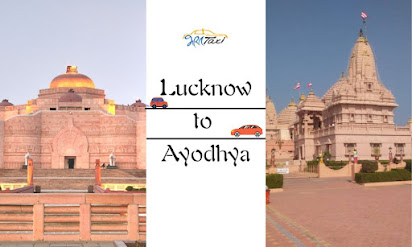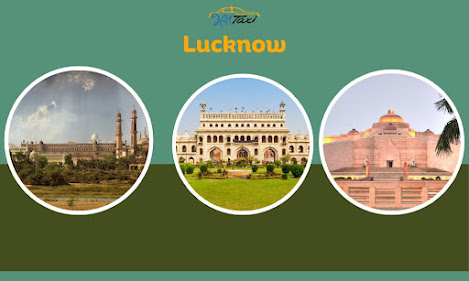Lucknow to Ayodhya on a pilgrimage road trip
Embarking on a pilgrimage road trip from Lucknow to Ayodhya can be a spiritually enriching experience. To make your journey smooth and enjoyable, here is some mandatory knowledge to keep in mind:
Distance and Route: The distance between Lucknow and Ayodhya is approximately 135 kilometers (84 miles) via the NH27 route. The journey takes around 3-4 hours, depending on traffic conditions. It's advisable to plan your trip accordingly, allowing for some extra time.
Transportation: You have several options for transportation, including private vehicles, taxis, or buses. If you need to drive yourself, consider booking a reliable taxi service from Lucknow to Ayodhya with Bharat Taxi.
Road Conditions: The road conditions between Lucknow and Ayodhya are generally good, with well-maintained national highways. However, it's essential to stay cautious while driving, follow traffic rules, and avoid overspeeding.
Weather: Check the weather forecast before your journey. Uttar Pradesh experiences hot summers and cool winters, so pack appropriate clothing and accessories accordingly. Carrying water bottles, umbrellas, and sunscreen is advisable, especially during the summer.
Fuel and Rest Stops: Before starting your journey, ensure that your vehicle has enough power. Along the route, you'll find various petrol stations where you can refill if needed. Additionally, there are several restaurants, dhabas (roadside eateries), and Rest stops where you can take breaks, stretch your legs, and enjoy local cuisine.
Accommodation
If you plan to stay overnight in Ayodhya, book hotels or guesthouses. Ayodhya offers a range of accommodation options to suit different budgets and preferences.
Pilgrimage Sites: Ayodhya is renowned for its sacred sites associated with Lord Rama. The most prominent ones include:
- The Ram Janmabhoomi (the birthplace of Lord Rama).
- Hanuman Garhi (a temple dedicated to Lord Hanuman).
- Kanak Bhavan Temple.
- The Dashrath Mahal (the residence of Lord Rama's father).
Plan your itinerary and allocate sufficient time to explore these significant places.
Dress Code and Etiquette:
While visiting temples and religious sites, it's essential to dress modestly and follow any specific dress codes mentioned at the entrance. Remember to remove footwear before entering temple premises and maintain a respectful demeanor throughout your visit.
Local Customs and Rituals:
Familiarize yourself with any local customs or rituals observed at the pilgrimage sites. Seek guidance from the temple authorities or local devotees to understand how to pay respects and participate in religious ceremonies.
Safety and Security:
As with any trip, prioritize your safety. Take care of your belongings, avoid isolated areas during odd hours, and remain cautious of your surroundings. In any emergency, keep contact numbers of local authorities, hotels, and emergency services handy.
Remember, a pilgrimage journey is about reaching the destination and the spiritual experience and inner connection. Enjoy the scenic beauty, immerse yourself in the spiritual ambiance, and embrace the journey with an open heart.
Distance between Lucknow and Ayodhya
The distance between Lucknow and Ayodhya is approximately 135 kilometers (84 miles) via the NH27 route.
Favorable time to visit Ayodhya
Ayodhya can be visited throughout the year, but specific periods are considered more favorable due to weather conditions and religious significance. Here are a few factors to consider when determining the excellent time to visit Ayodhya:
Weather:
Ayodhya experiences hot summers, with temperatures soaring between April and June. The monsoon season, from July to September, brings moderate to heavy rainfall. The winter months, from November to February, offer pleasant weather with temperatures ranging from mild to excellent. The best time to visit Ayodhya in terms of weather is during the winter when the climate is comfortable for exploring the city and its temples.
Festivals:
Ayodhya is known for its grand celebrations and festivals, making visiting these times particularly auspicious. The most significant festival in Ayodhya is Diwali, the festival of lights celebrated with great enthusiasm and devotion. Other important festivals include:
- Ram Navami (Lord Rama's birthday).
- Navaratri (nine nights dedicated to Goddess Durga).
- Kartik Purnima (celebration of Lord Rama's return to Ayodhya).
If you wish to witness vibrant festivities and cultural fervor, plan your visit during these festival periods.
Ramayana Circuit:
Ayodhya is part of the Ramayana Circuit, which includes other destinations associated with Lord Rama's life and adventures. If you want to explore the entire circuit, plan your visit during the cooler months to make the journey more comfortable.
Crowds:
Ayodhya attracts devotees and tourists throughout the year, but specific periods witness higher footfall. If you prefer a quieter and more serene experience, consider visiting during non-peak times.
Considering these factors, the best time to visit Ayodhya is generally during the winter months (November to February) when the weather is pleasant and several important festivals are celebrated. However, it ultimately depends on your personal preferences and priorities. It's advisable to check the specific dates of festivals and plan accordingly to make the most of your visit to Ayodhya.
Places that serve delicious food in Ayodhya
Here are some popular food joints and restaurants in Ayodhya that serve mouthwatering dishes:
Gupta Chaat Bhandar:
This iconic eatery in Ayodhya is famous for its delectable chaat (Indian street food). From crisp samosas and Golgappas (pani puri) to aloo tikki and dahi vadas, Gupta Chaat Bhandar offers a wide variety of flavorful snacks that are a must-try.
Ayodhya Prasad: Located near the Ram Janmabhoomi temple, Ayodhya Prasad is a popular vegetarian restaurant that serves authentic North Indian cuisine.
Bansal Bhojanalaya: Bansal Bhojanalaya is a renowned restaurant in Ayodhya that serves delicious vegetarian food. They offer a diverse menu, including North Indian, South Indian, and Chinese dishes. Their thali meals and a la carte options are popular among locals and visitors.
Ram Shyam Hotel:
Ram Shyam Hotel is a well-known eating joint in Ayodhya, particularly famous for its sweets and snacks. You can relish traditional Indian sweets like jalebi, Rabri, and gulab jamun, along with savory snacks like kachori and samosa.
Ramayan Bhawan:
This vegetarian restaurant near the Ram Janmabhoomi temple is popular with tourists and pilgrims. They serve various dishes, including North Indian, South Indian, and Chinese. The restaurant has a pleasant ambiance and provides a comfortable dining experience.
Ayodhya Café:
Ayodhya Café is a cozy café near the Hanuman Garhi temple. It offers a range of snacks, sandwiches, and beverages.
Janki Bhojnalaya:
Situated near the Kanak Bhavan Temple, Janki Bhojnalaya is a popular spot for vegetarian meals. They serve traditional North Indian dishes, including thalis and a variety of curries and bread. These are just a few of the many options available in Ayodhya.
Ayodhya, a city with a rich culinary heritage, offers several dishes famous for their unique flavors and traditional preparation. Here are a few words that are popular in Ayodhya:
Makhan Malai:
Makhan Malai is a famous winter dessert in Ayodhya. It is a creamy and airy delicacy made with fresh milk, saffron, and nuts.
Gujiya:
Gujiya is a sweet dumpling commonly prepared during festivals like Holi and Diwali. It is made with a sweet filling of khoya (reduced milk), dry fruits, and coconut, then deep-fried to golden perfection. Gujiyas are often enjoyed with a sprinkle of powdered sugar.
Dubki Kachori:
Dubki Kachori is a popular street food in Ayodhya. It consists of a deep-fried, crisp pastry shell filled with a tangy and spicy mixture of lentils, spices, and curd.
Dal Puri:
Dal Puri is a delicious and wholesome dish enjoyed in Ayodhya. It is made by stuffing a spiced lentil mixture into wheat flour dough and deep-frying it. The crispy puris are served with a flavorful dal (lentil curry) and often accompanied by pickles.
Lassi:
Lassi is a refreshing yogurt-based drink that is popular in Ayodhya. It is made by blending yogurt with water and sugar and is sometimes flavored with ingredients like saffron, cardamom, or rose water. Lassi is served chilled and is a perfect beverage to beat the heat.
Peda:
It is a traditional Indian sweet widely enjoyed in Ayodhya. Peda is soft and creamy and often garnished with pistachios or silver leaf.
These are just a few examples of the delightful dishes that Ayodhya has to offer. Exploring the local food joints and sweet shops will give you an opportunity to savor the authentic flavors of Ayodhya.
Explore Ram Janmbhoomi on your holiday this year to make it spiritual. Enjoy your journey with Bharat Taxi from Lucknow to Ayodhya. You can book your best choice of taxi service in Lucknow for your journey.



Comments
Post a Comment